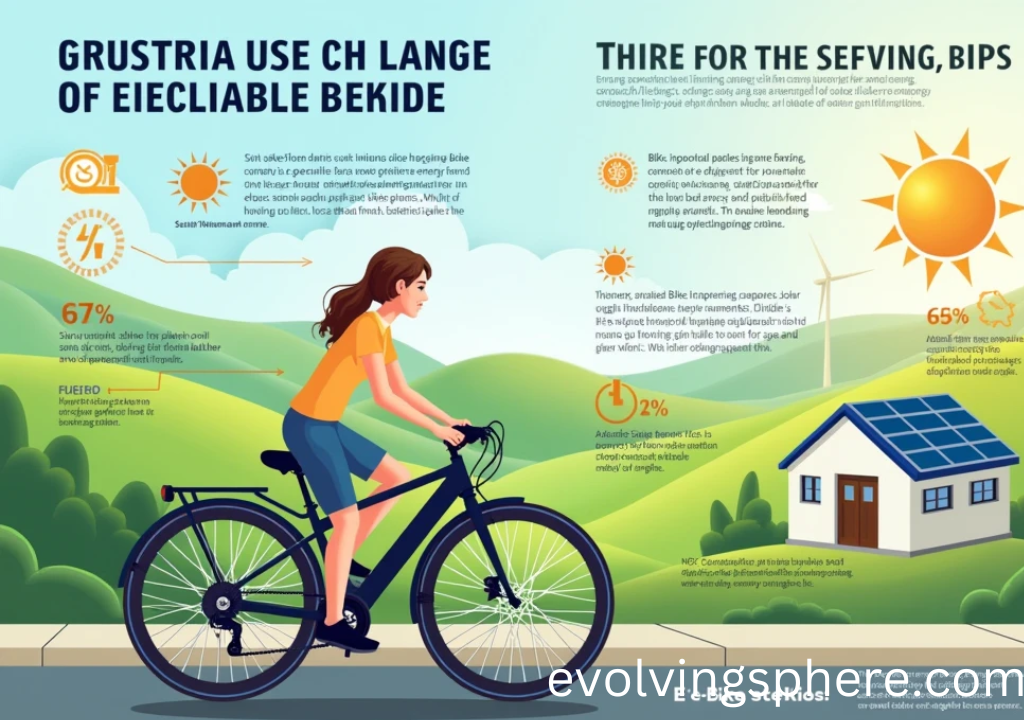The Ultimate Guide to Solar Charging E bike Energy As electric bikes (e-bikes) continue to revolutionize urban commuting and outdoor adventures, the search for sustainable charging methods has gained momentum. Solar charging, an eco-friendly alternative to grid electricity, presents a promising solution. But how effective is it? This guide dives into the technicalities, benefits, and limitations of solar charging for e-bikes.
Understanding Solar Charging for E-Bikes
Solar charging involves using photovoltaic (PV) panels to convert sunlight into electricity, which then charges the e-bike’s battery. The process typically includes these components:
- Solar Panels: Capture sunlight and convert it into direct current (DC) electricity.
- Charge Controller: Regulates the voltage and current coming from the solar panels to prevent overcharging The Ultimate Guide to Solar Charging E bike Energy.
- Battery Pack: Stores the energy for later use or directly powers the e-bike.
- Inverter (optional): Converts DC electricity into alternating current (AC) if needed for specific chargers.
Benefits of Solar Charging E-Bikes
- Sustainability: Solar energy reduces reliance on fossil fuels, cutting down carbon footprints.
- Portability: Compact, foldable solar panels enable off-grid charging during long rides or camping trips.
- Cost Savings: Once installed, solar charging slashes electricity bills.
- Energy Independence: Cyclists can charge their bikes anywhere the sun shines, eliminating range anxiety.
Limitations and Challenges
- Weather Dependency: Solar charging efficiency drops during cloudy days or in shaded areas.
- Slow Charging: Charging times are longer compared to wall outlets, often taking 6–12 hours for a full charge.
- Initial Costs: Solar panels, controllers, and battery storage systems require a significant upfront investment.
- Space Requirements: Larger panels produce more power but can be cumbersome for urban commuters.
Technical Considerations
When setting up a solar charging system for your e-bike, factor in these technical aspects:
- Power Output: Ensure your solar panel’s wattage matches or exceeds your e-bike battery’s requirements. For example, a 500Wh battery paired with a 100W panel may take approximately 5–6 hours of direct sunlight to fully charge.
- Charge Controller Type: MPPT (Maximum Power Point Tracking) controllers are more efficient than PWM (Pulse Width Modulation) options The Ultimate Guide to Solar Charging E bike Energy.
- Battery Compatibility: Verify that your e-bike’s battery voltage (36V, 48V, etc.) aligns with the solar system.
- Portability: Consider foldable or rollable solar panels for on-the-go charging.
Best Solar Charging Setups for E-Bikes
- Portable Solar Chargers: Lightweight, foldable panels with built-in USB or DC outputs for easy travel.
- Fixed Solar Installations: Roof-mounted setups for home-based charging stations.
- Hybrid Systems: Combining solar charging with traditional grid power to balance efficiency and reliability.
You May Also Like: Pickleball Fitness
Future of Solar Charging for E-Bikes
Innovations in solar technology, such as higher-efficiency panels and integrated solar bikes, are pushing the boundaries of sustainable transportation. Emerging trends include:
- Solar-integrated E-Bikes: Built-in panels on e-bike frames for trickle charging during rides.
- Smart Solar Systems: AI-powered controllers that optimize charging times based on weather patterns.
- Energy Storage Solutions: Advanced battery packs capable of storing surplus solar energy.
Conclusion
Solar charging for e-bikes holds immense potential for sustainable commuting. While current technology has its limitations, ongoing advancements are paving the way for faster, more reliable solar solutions. Whether you’re an eco-conscious commuter or an off-grid adventurer, understanding the nuances of solar charging empowers you to make informed decisions for a greener ride.

As e-bikes gain popularity for their eco-friendliness and convenience, solar charging has emerged as a game-changer for sustainable commuting. Harnessing solar energy to power your e-bike not only reduces your carbon footprint but also offers an off-grid solution for longer adventures.
Why Choose Solar Charging for Your E-Bike?
Solar charging eliminates the need for traditional electricity sources, allowing you to charge your e-bike anywhere the sun shines. It’s perfect for outdoor enthusiasts, campers, and long-distance riders seeking independence from power outlets. Plus, it helps cut energy costs and supports green living.
How Does Solar Charging Work?
A solar charging setup typically includes:
- Solar Panels: Portable or fixed panels that capture sunlight and convert it into electricity.
- Charge Controller: Regulates the voltage to protect your e-bike battery from overcharging.
- Battery Pack: Stores energy for later use, ensuring you can charge even when the sun goes down.
Benefits of Solar-Powered E-Bikes
- Sustainability: Uses clean, renewable energy.
- Portability: Charge on the go during bikepacking trips.
- Cost-Effective: Lowers electricity bills over time.
- Independence: No need to rely on charging stations or outlets.
Tips for Efficient Solar Charging
- Choose the Right Panel: Opt for a high-efficiency panel (100W–200W) for faster charging.
- Angle Panels Correctly: Adjust them to capture maximum sunlight.
- Monitor Battery Health: Ensure your battery is compatible with solar charging.
Embracing solar charging for your e-bike is a smart move toward sustainable mobility. With the right setup, you can ride longer, save money, and help the planet—one sunny ride at a time.
Would you like me to dive deeper into solar panel options or create a custom setup guide? Let me know!
Solar Charging E-Bike Energy: Frequently Asked Questions (FAQ)
1. Can I charge my e-bike directly with solar panels?
Yes! You can charge your e-bike directly using solar panels, but you’ll need a solar setup that includes a compatible inverter or charge controller to regulate the energy flow. Ensure the panel’s output matches your e-bike battery’s voltage.
2. How many solar panels do I need to charge my e-bike?
Typically, a single 100W solar panel can charge a 36V e-bike battery in about 6–8 hours of direct sunlight. The exact number of panels depends on your battery capacity and desired charging speed.
3. Is solar charging slower than plugging into a wall outlet?
Yes, solar charging is generally slower since it relies on sunlight intensity. However, using a well-designed solar setup can still fully charge most e-bike batteries within a day.
4. What size battery can a solar charger handle?
Most portable solar chargers can handle e-bike batteries ranging from 36V to 48V, but it’s crucial to check your solar charger’s output specifications to ensure compatibility.
5. Can I ride my e-bike while it’s charging via solar?
Not usually. Most solar setups are designed for stationary charging, though some advanced systems may support “trickle charging” while riding. It’s safer and more efficient to charge when parked.
6. What happens if there’s no sun?
On cloudy days, solar charging slows down significantly. To combat this, some riders use a solar generator to store energy during sunny hours for later use.
7. Do I need any extra equipment for solar charging?
Yes! A basic solar charging setup includes:
- Solar panels (foldable or fixed)
- Charge controller (to prevent battery overcharging)
- Inverter (if your battery requires AC input)
- Battery pack (optional, for storing solar energy)
8. Is solar charging safe for my e-bike’s battery?
Absolutely — as long as you use a charge controller to regulate the voltage and current, solar charging is safe and can even extend your battery’s life by preventing overcharging.
9. Can I build a DIY solar charging station for my e-bike?
Yes! Many enthusiasts build custom solar stations using portable panels, controllers, and battery packs. Just make sure to match the output to your e-bike’s battery needs.
10. Are there solar charging kits available for e-bikes?
Yes, several brands offer solar charging kits designed specifically for e-bikes. These kits usually include foldable solar panels, a charge controller, and all necessary cables.





